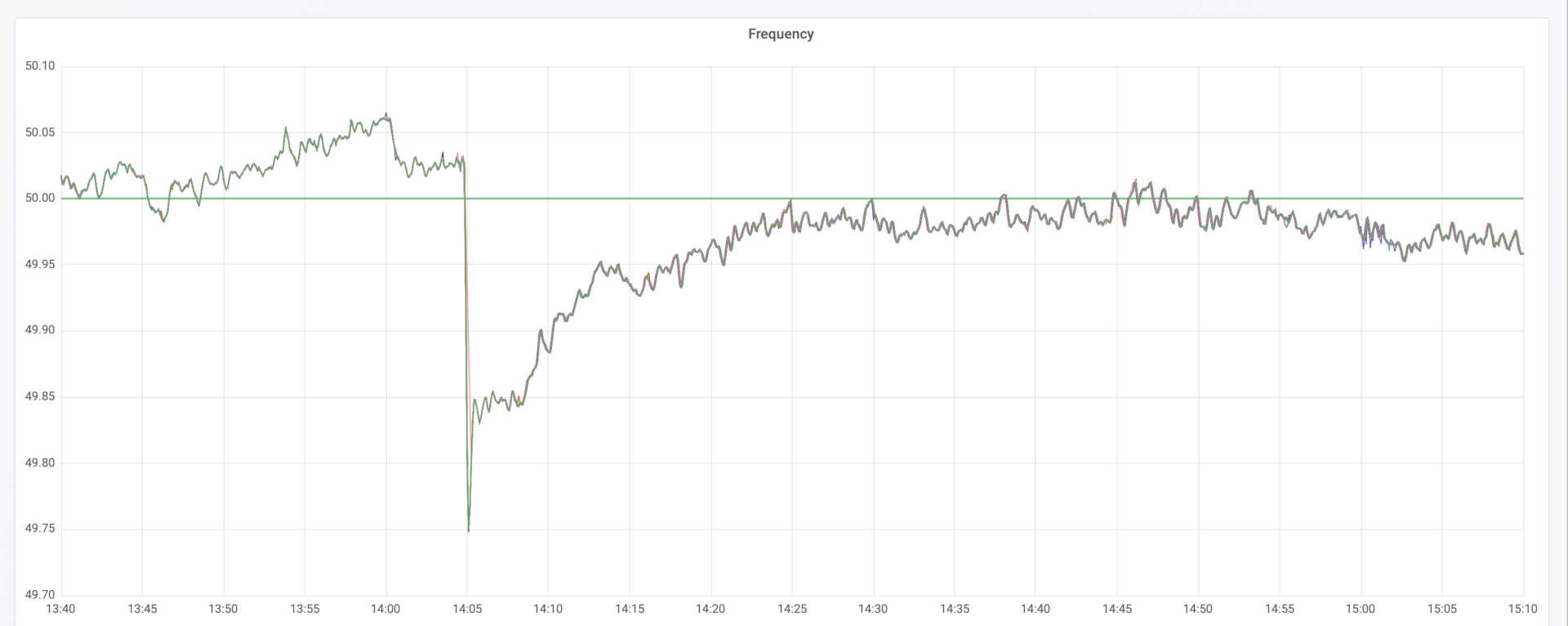
Continental-European grid frequency drops below 49.75 Hz – system split ensues
On Friday, 08 January 2021, at 14:05:07 (CET) the Continental European grid frequency dropped below 49.75 Hz. Such a tremendous frequency drop is highly unusual. Before 14:04:54, the frequency was pegged around 50.02 and 50.03 Hz for about three minutes. Within 13 seconds a drop by almost 270 mHz was observed. ENTSO-E, the European Network of Transmission System Operators reported a system split between 14:05 and 15:08.
A frequency drop of this size cannot be explained by a single power plant outage. Also trading effects are unlikely to have driven the frequency down with such a steep slope. Most notably a considerable amount of time had passed after the turn of the hour, it being the point in time where large jumps in frequency are observed. 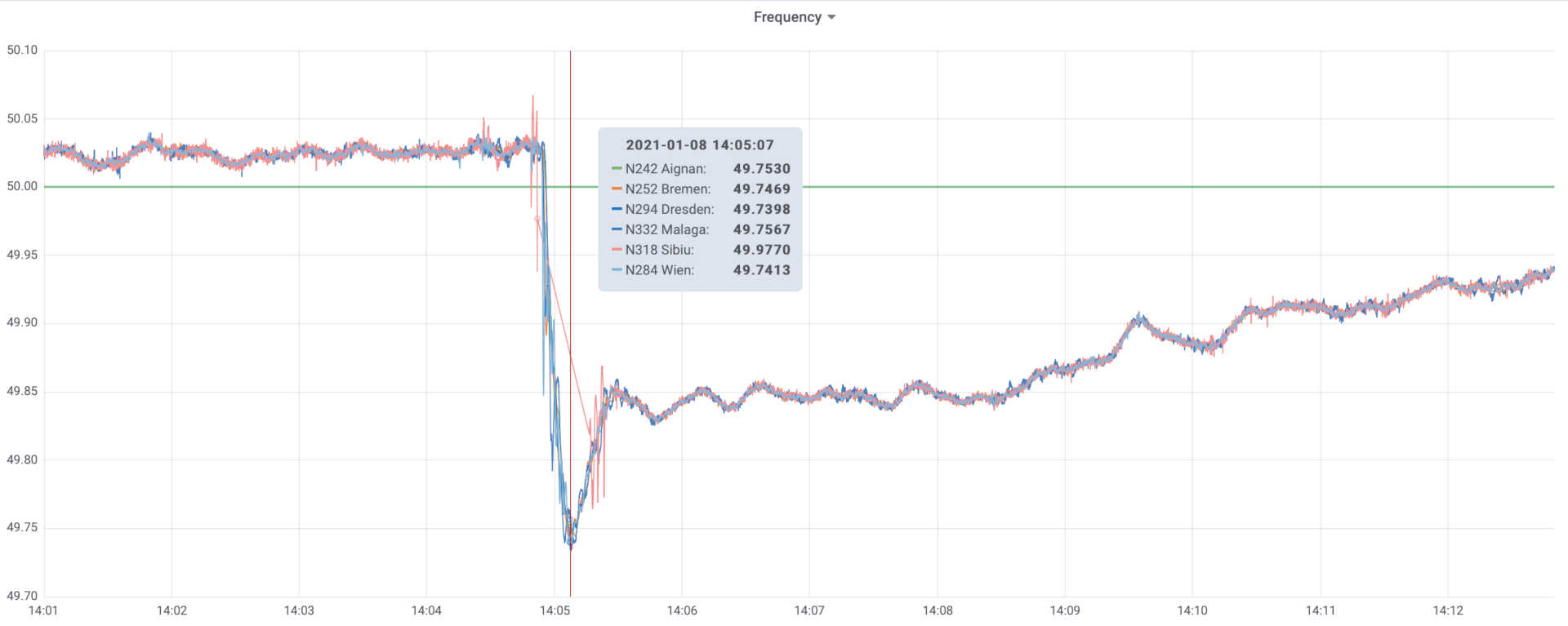 Closer inspection of the frequency drop along the European measurement units shows the origin of the event to be in southeastern Europe (s. next graph). The first PMU to detect the event was our measurement unit in Sibiu. The subsequent break in data transmissions from Sibiu can be explained by a undervoltage event in Romania's north west. The frequency drop was subsequently registered in Ljubljana, Vienna, Prague and Dresden and finally in Belfort in western France with the impact decreasing along the path. The slope of the frequency plot right after the first drop gives a good indication that the origin was in southeastern Europe and spread from there.
Closer inspection of the frequency drop along the European measurement units shows the origin of the event to be in southeastern Europe (s. next graph). The first PMU to detect the event was our measurement unit in Sibiu. The subsequent break in data transmissions from Sibiu can be explained by a undervoltage event in Romania's north west. The frequency drop was subsequently registered in Ljubljana, Vienna, Prague and Dresden and finally in Belfort in western France with the impact decreasing along the path. The slope of the frequency plot right after the first drop gives a good indication that the origin was in southeastern Europe and spread from there. 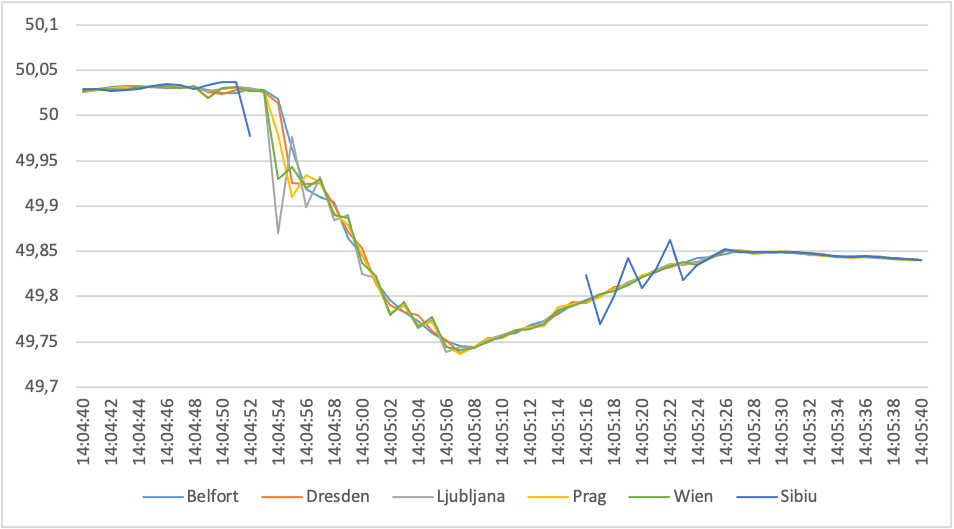 An analysis of the phase angle difference affirms our above observation. Phase angle differences enables conclusions to be drawn about power shifts between sites on the grid. In the long term, this allows one to identify feed-in and feed-out regions or power flows within the grid. In the short term, the analysis of the phase angle difference helps identify sudden power flow changes. The following plot of the phase angle difference, with Belfort as a reference point, displays the events during the system split: The separation of the grid around 14:04 can be clearly identified. The regional consequences are also clearly visible. The further the PMU is located in south-eastern Europe, the stronger the (negative) deviation compared to the starting time.
An analysis of the phase angle difference affirms our above observation. Phase angle differences enables conclusions to be drawn about power shifts between sites on the grid. In the long term, this allows one to identify feed-in and feed-out regions or power flows within the grid. In the short term, the analysis of the phase angle difference helps identify sudden power flow changes. The following plot of the phase angle difference, with Belfort as a reference point, displays the events during the system split: The separation of the grid around 14:04 can be clearly identified. The regional consequences are also clearly visible. The further the PMU is located in south-eastern Europe, the stronger the (negative) deviation compared to the starting time.
On 26 January 2021, ENTSO-E published the results of its analysis of the incident. According to the report, there was an overload of a busbar coupling in a substation in Ernestinovo in Croatia. A protective trip at 14:04:26 disconnected the two connected busbars. Subsequently, a cascade of followup effects set in. This was because the load flows through the substation in Ernestinovo had to be distributed across other lines and substations. Due to the sudden changes at other stations, further disconnections occurred at neighbouring substations to the west and east of Ernestinovo, which finally resulted in the splitting of the grid according to the figure published by ENTSO-E: 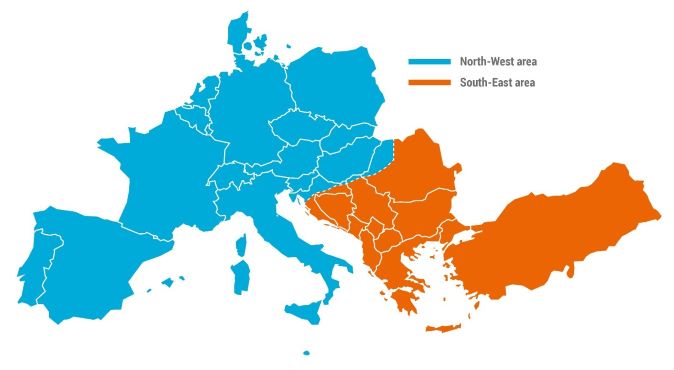 Figure was taken from the ENTSO-E report on the incident
Figure was taken from the ENTSO-E report on the incident
The rebound can also be seen accordingly. The reconnection at 15:08 generally only showed a short-term effect at the measuring station in Prague. The phase jumps show that there were still problems with the power plants in the greater region afterwards. All other PMUs, including the one in Sibiu, show a continuous synchronisation effort. This figure shows the ideal-typical effect of a break-up and subsequent interconnection with regard to the power in the grid: First, there is a massive change in power between generation regions and consumption regions. Consumption regions all of a sudden lack power, generating regions, on the other hand, have a power overhang. Then the protective mechanisms of power plants and large loads take effect. The plants are abruptly disconnected from the grid (see frequency drop in the above diagram). The transmission grid operators then co-ordinate the consolidation by balancing and stabilising power on a supra-regional basis. The French and Italian transmission system operators RTE and Terna had disconnected loads of 1300 MW and 1000 MW respectively. The reconnection, on the other hand, had a massive impact especially where particularly large amounts of power had been made available. Optimally, this excess power should be disconnected the very moment the reconnection takes place.
However, this is not perfectly possible due to the momentum of the flywheel masses. 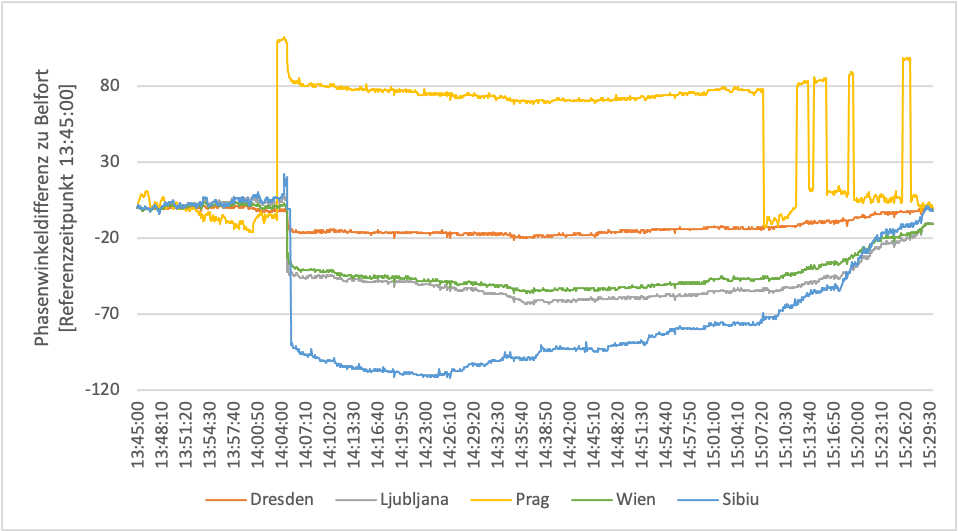
If we take a closer look at the beginning of the break-up, further conclusions about the origin of the event can be drawn: From 14:04:18 onwards, the station in Sibiu was the first to notice a phase angle shift. At 14:04:49, there was an almost simultaneous drop in power in Prague, Ljubljana, Vienna, Prague and Dresden. The region in northwestern Romania presumably initially absorbed the resulting power imbalance, but was probably unable to cope. This is why a vector jump occurred at around 14:05:16.
Some data was lost due to a voltage drop in northwestern Romania, including Sibiu causing our PMU to reboot. 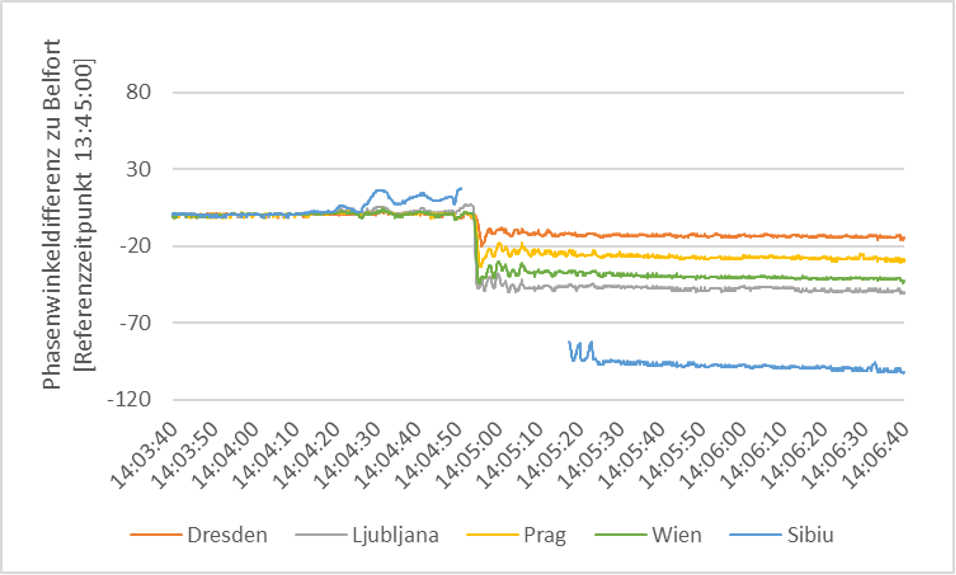 The speed with which the frequency drop occurred is particularly striking. The gradient of the frequency drop and the impact of the Krsko NPP scram on 29.12.2020 as a result of an earthquake also show that the causes cannot be attributed to this event, but must be sought on the system side.
The speed with which the frequency drop occurred is particularly striking. The gradient of the frequency drop and the impact of the Krsko NPP scram on 29.12.2020 as a result of an earthquake also show that the causes cannot be attributed to this event, but must be sought on the system side.
Apparently, there are too few power plants connected to the grid to be able to provide a sufficient amount of instantaneous reserve. Instantaneous reserve refers to the flywheel masses that are continuously connected to the grid, such as the turbine sets of large power plants. Flywheels help absorb rapid frequency changes. This is also indicated by statements of the French transmission grid operator RTE. RTE currently asked French consumers to reduce their energy consumption.
Similar to almost exactly two years ago, winter leads to a continuously high load on the energy system. On 10 January 2019, a comparatively inconspicuous event therefore also led to a massive drop in frequency below 49.8 Hz. The reduced industrial energy demand due to Corona has further tightened the situation. This is because extensive power plant capacities were removce from the grid across Europe last year. This situation, challenging in several ways, has brought the continental European interconnected system to the brink of blackout. In the meantime, we know that the grid split on 08.01.2021 did not remain without consequences on the consumption side in Western Europe. We have been told that the frequency jump led to protective shutdowns of running plants and thus to interruptions in production.
Seemingly, such irregularities have occurred frequently in the recent past, but so far they have not been associated with grid events. However, our long-term analyses and our monitoring system show - with a 100 MHz deviation occuring almost daily since the beginning of January 2021 - that there are increasingly larger frequency deviations above 100 MHz in the winter half-year.
Gridradar wants to increase transparency of the grid. You are welcome to support our venture by connecting your PMU to our PDC. In return you will receive data from our Gridradar wide area monitoring system. Also do contact us if you are interested in setting up a PMU at your site.
27.01.2021 1100 hours
